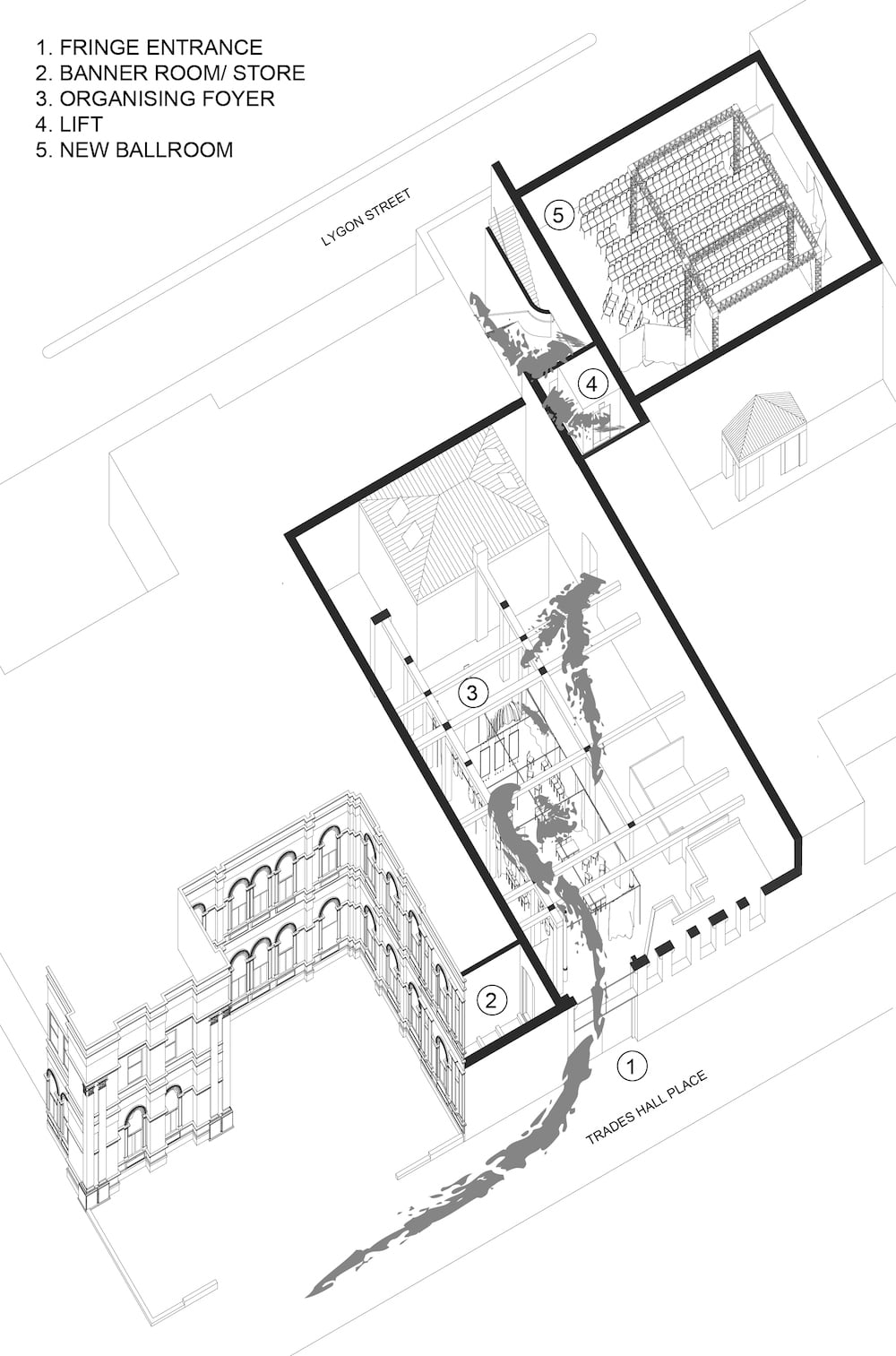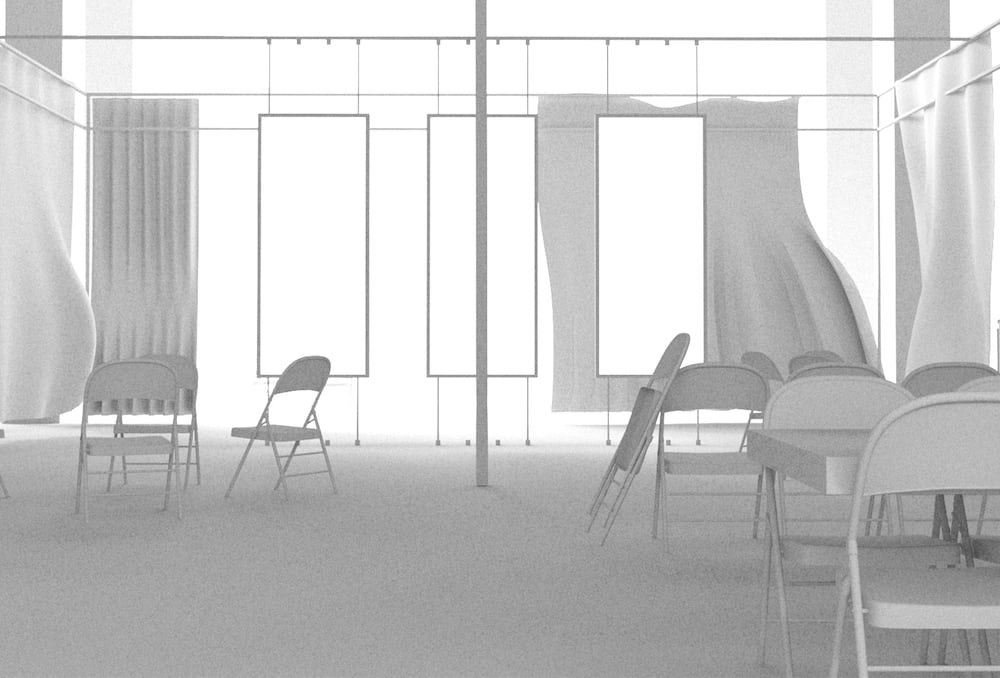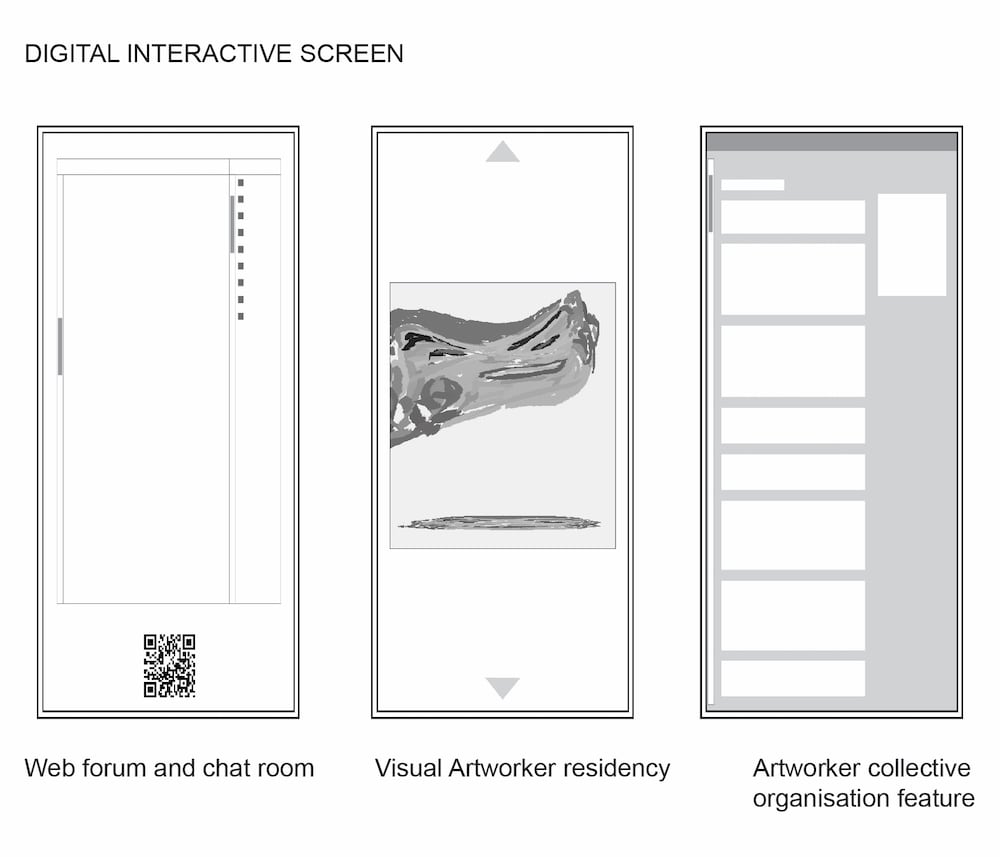It is not kind to laugh at other people’s art. Seated on a grass lawn a few blocks away from Fringe Festival’s new home in Trades Hall, the three of us shared a moment of comedy thinking about the radical potentialities which might emerge as moustache twiddlers collide with staunch trade union militants. Connecting the material conditions of today to historical collaborations between artworkers and unions in the space of Trades Hall, this site-specific case study has allowed us to consider the potential for practices of care as solidarity in the Victorian labour movement. These practices can be revived to traverse the spaces between art’s aesthetics and the conditions of production.1 The labour movement as a whole seeks to protect and advance the cause of workers within capitalism, practiced through collective organising within trade unions on the one hand, and political activism on the other. Our project is framed by a need to reinvigorate the labour movement within and beyond the union movement. We propose a speculative architectural response to the challenges facing artworkers and the union movement in the form of organising foyers at the entrances to the rooms which will host Fringe performances in Trades Hall. This spatial exercise problematises the collective role of artworkers within the labour movement in addressing the increasing spectre of precarious work within the neoliberal economic paradigm. We offer this concept to provoke radical experimentation among artworkers, engendering new modes of organising amongst the precariat at large.
Our focus on the relationship between artworkers and unions is informed by a need for adaptive solutions to the global and local dilemmas facing the labour movement. Practices of care as solidarity should consider the unique position of the artworker within the newly emerging precariat class. The term artworker is used contrary to the dominant distinction between artist and worker to expansively and non-exhaustively denote professional workers in the arts sector.2 Artworkers’ long experience of insecure relations with production, distribution and the state position them today as prototypical members of the newly emergent precariat class, whose distinctive relation to production is insecurity.3 Artworkers have historically endured these precarious conditions largely in isolation from the majority of the workforce. Their contemporary place within the precariat is informed by these long-held historical experiences. Precarity points to the contingency of this condition — these workers’ experiences of labour insecurity are dependent not on negotiated agreements with employers or industry standards, but rather on the needs of the globalised market.^4 We speak to artworkers as ‘non-standard non-blue-collar’ workers who, contrary to public opinion, could practice care as solidarity with the unions.5
Our speculative installation of organising foyers is an exercise in considering how artworkers could come together, incidentally as attendees of Fringe, then consciously as members of a precariat class. We propose two entwined installations. Echoing the formal qualities of union banners, we will install curtains as spatial dividers across the existing columns throughout the eleven venues of Trades Hall. By virtue of heritage limitations which prohibit permanent fixtures to the walls, the foyers would essentially function as temporary installations, with adaptable configurations depending on the expected capacities of each venue.6 The foyers shrink in the smallest ‘Toy Library’ to serve twenty-nine people, expanding to host 213 visitors in the ‘New Ballroom’.7 The spatial dividers give Trades Hall the capacity to adapt to the needs of precarious workers and to the notion of precarity in and of itself. In the centre of the largest foyer we will affix three screens to the ceiling using wires shaped like the pulleys that currently harness the banners elsewhere in the hall, whose displays would promote and enable artworker organising online and in the space. Care is using the space of Trades Hall in this way to promote artworkers organising in inchoate solidarity.
Collective solidarity across the workforce involves caring about the past, the present and the future of working life in ideological, aesthetic and material ways. Our vision for contemporary solidarity in Trades Hall is inspired by the generative period of mutual material reciprocity between trade unions and artworkers in the 1980s.8 Unions engaged with the diverse cultural needs of the labour movement by increasing the range of artworkers they employed in an ongoing capacity early in the decade.9 The Art and Working Life movement funded by the Australian Council of Trade Unions (ACTU) and the Australia Council for the Arts from 1982–86 exemplified this culture of support by building on the cultural traditions of the labour movement in a ‘direct and dependent fashion’ to establish projects linking artworkers and trade union members alike in cultural production and organising.10
The Trades Hall Banner Project born of this program exemplifies how unions can tangibly enable care between artworkers and workers in general as solidarity. The project was part of a larger project reviving the traditional banner-making practices of the labour movement which sought to communicate the centrality of artistic activity to a unified labour movement. Unionist and artworker Geoff Hogg directed the banners’ production in the tradition of early twentieth century union cultural practices, depicting various Victorian workers in a Social Realist style.11 The banner then served as a major communal art object. It was unfurled in marches in the tradition of the days of the 8 Hour Day March as a ritual which aesthetically manifested a unifying collective identity among workers.12 Subsequently, the unions commissioned eight new banners, a mural and the creation of an Artists’ Workshop within Trades Hall, which lives on today.13 On a symbolic level, the works unified disparate workers through art as ritual. Materially, artworkers were financially remunerated for their work on the Trades Hall Banner Project and in further programs. Our design framework for the foyer concept was informed by the way this banner project demonstrated potential for practices of care between artworkers and unions to generate collective consciousness.
The relationship between artworkers and trade unions flourished on the basis of the material conditions of that time. In the shadow of the changed neoliberal economy and the resultant landscape of arts funding, the conditions which enabled a ‘brief golden moment’ of care practices in the 1980s have declined.14 The complex interaction of forces like globalisation, digitisation and union frigidity have contributed to the contemporary shared experience of precarity among a growing majority of workers. For many, permanent, single-employer work and a structural ability to negotiate with employers has been replaced with casual employment, low earnings and an overreliance on enterprise agreements.15 All of these experienced conditions are magnified for people of marginalised positionalities pertaining to gender, ethnicity, visa status and ability.16 The landscape of work in Australia is fast shifting towards overwhelming precarity. Fifty-seven per cent of all net new jobs in the country from 2012–17 have been part time, while less than half of working Australians have permanent full-time jobs with paid benefits.17 Collaborative pursuits between unions and artworkers are but historical relics in this configuration of labour norms.^18
The contemporary worker’s struggle for quality work and life exceeds the traditional union agenda, which continues to be based on the receding work paradigm of the twentieth century. In the precursory work paradigm of western ‘industrial society’, the density of union membership in Australian society rendered the union movement largely synonymous with the labour movement.19 In comparison to the strict separation between work and domestic life in industrial society, the ‘tertiary society’ of the globalised world of the now involves a social framework of flexibility wherein the majority of workers experience their hours of labour blended in between home and traditional work spaces.20 In 1954, 62 per cent of the Australian workforce were union members. Today, as the precarious tertiary society spreads, the number sits at approximately 15 per cent.21
Although long familiar with the conditions of precarity as isolated individuals, artworkers today have the opportunity to leverage their capital as members of a unifying precariat class. Artworkers can benefit from the structures of labour organising which in prior times appeared largely inaccessible for the conditions of their labour. Care should involve bringing the creative capital of artworkers together with the institutional capital of the union movement. The physical capital of Trades Hall, its institutional knowledge of large scale organising and its membership, can be used for an effective struggle against neoliberal precarity and the diffusion of workers’ collective consciousness. The current membership density of the unions still represents a significant portion of organised civil society whose collective power should not be underestimated.
By comparison, artworkers hold creative capital largely in individual capacities that elude traditional modes of collective organising. Within the current systems of neoliberal capitalism, creative capital is a resource possessed by artworkers which can and should be leveraged collectively to improve working conditions and quality of life. This form of capital pertains to the market value of the skills, resources and output of artworkers in a world which perceives art as a high value commodity for the ways its production evades the logics of automation and subcontracting.22
The perverse creative and cultural industries which seek to exploit this mode of capital have increased investment in audiences as consumers of art on an unprecedented popular scale.23 The Victorian Government has created an expansive arts funding apparatus assuming that modest investments in the arts will generate financial returns which exceed the rate of growth of most other sectors.24 According to a report by the Boston Consulting Group in 2015, outputs by these industries represented 8 per cent of the entire Victorian economy in 2012–13.25 The Bureau of Communications and Arts Research assessed the value of creative and cultural activity in Australia, particularly looking at 2016–17 wherein these modes comprised nearly 7 per cent of the overall GDP, and argued that these assets are more than likely to grow in the near future.26
The trickle-down effect persists as a mythology: although more capital is circulating, the quality of working life for precarious artworkers remains fraught.27 Artworkers need a mode of mediation which supports increasing access to remuneration for their labour while preserving the integrity of their work beyond the clutches of the market. As per Rosemary Forde, unless the dominant modes of neoliberalism are consciously critiqued, attempts by artworkers to engender some semblance of stability by adhering to the norms of this system are less likely to enact structural change than they are to increase the symptoms of precarity.28 The struggle of the labour movement is the mediation between the needs of workers and the demands of the capitalist system of exploitation. Artworkers can and should resist the imperative to operate purely within the logics of the market. By leveraging the new and old modes of capital in this system with an ethic of solidarity as care, artworkers can build materially substantial norms of working life.
The success of collaborative organising in the 1980s was a conscious response to the material conditions of the time, tied with an aesthetic consciousness around a collective identity as a labour movement. In spite of specific union policies which seek to respond to the new precarious economic paradigm, solidarity remains sorely missed across the contemporary workforce. Current and future unions should pay attention to the cultural traditions of the labour movement. This rich cultural background can underpin new material support for artworkers as members of an occupational sector in need of organising.
With the promise of creative capital on the backs of artworkers, the union movement must make amends for its stagnation. Physical and conceptual room for the precariat
class must be made in union spaces such as Trades Hall, whose value as physical capital should not be relegated to heritage stasis. Opening the space for organising among the artworker precariat is just one way of using the capital of the union to its full potential. In our Fringe foyers, we imagine artworkers wandering through Trades Hall with the goal of watching shows. We hope they will be surprised and intrigued by the spatial invitation for solidarity. Although unions and artworkers appear separate in physical terms, we envisage the installation as a means of inspiring a regenerated coalescence between the two around the values of the labour movement.
This is a particular historic moment wherein unions and artworkers can mobilise their resources collectively against precarity. The unions and artworkers together have the various forms of capital and knowledge needed to resist the present iteration of normalised worker exploitation. There are myriad ways this relationship can be reinvigorated, and to consider how the materials of production today can foster new modes of collective solidarity. The specificities of these processes must be determined by the workers. See you in the foyer, comrades.
We would like to thank Imogen Beynon, Jacqueline Doughty, John Hughes, Mary Leunig, Leon Norster, Sam Wallman and Trades Hall for generously sharing their expertise and experiences with us, without which this piece would not have been possible. Finally, join or make a union!
Cameron Hurst (she/her) is an emerging art historian who recently completed her Bachelor of Arts (Art History and Gender Studies) at the University of Melbourne. Her research interests are in social art histories situated locally in Naarm/ Melbourne. She is a white middle-class settler and a member of HospoVoice.
Babs Rapeport (they/them) is an Ashkenazi Jewish settler of middle class background living and working in precarity on unceded Kulin Nation lands. Their work involves reflecting upon the responsibilities incumbent upon them and their respective communities in relation to their co- constituted political and legal subjectivities. They are a member of HospoVoice.
Dominique Tang (she/they) is a recent graduate of the Masters of Architecture at the University of Melbourne and is interested in applying architectural design to different types of spaces in service of diverse occupants. She collaborates with others in creating and performing music and graphic art..



